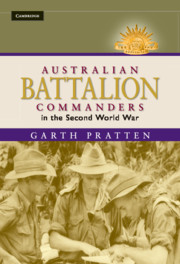Book contents
- Frontmatter
- Dedication
- Epigraph
- CONTENTS
- List of maps and figures
- Military symbols on maps
- ACKNOWLEDGEMENTS
- NOTES ON THE TEXT
- List of abbreviations
- INTRODUCTION
- CHAPTER 1 ‘COMPLETELY UNTRAINED FOR WAR’
- CHAPTER 2 THE FOUNDATIONS OF BATTALION COMMAND
- 3 ‘WE WERE LEARNING THEN’
- CHAPTER 4 DESERT EPILOGUE
- CHAPTER 5 VICTIMS OF CIRCUMSTANCE
- CHAPTER 6 ‘NO PLACE FOR HALF-HEARTED MEASURES’
- CHAPTER 7 ‘THERE IS NO MYSTERY IN JUNGLE FIGHTING’
- CHAPTER 8 ‘EXPERIENCED, TOUGHENED, COMPETENT’
- CONCLUSION
- APPENDIX 1 THE DEMOGRAPHICS OF AUSTRALIAN BATTALION COMMANDERS
- APPENDIX 2 PERIODS OF COMMAND
- NOTES
- BIBLIOGRAPHY
- INDEX
CHAPTER 2 - THE FOUNDATIONS OF BATTALION COMMAND
Forming the 2nd AIF, 1939–40
Published online by Cambridge University Press: 18 December 2014
- Frontmatter
- Dedication
- Epigraph
- CONTENTS
- List of maps and figures
- Military symbols on maps
- ACKNOWLEDGEMENTS
- NOTES ON THE TEXT
- List of abbreviations
- INTRODUCTION
- CHAPTER 1 ‘COMPLETELY UNTRAINED FOR WAR’
- CHAPTER 2 THE FOUNDATIONS OF BATTALION COMMAND
- 3 ‘WE WERE LEARNING THEN’
- CHAPTER 4 DESERT EPILOGUE
- CHAPTER 5 VICTIMS OF CIRCUMSTANCE
- CHAPTER 6 ‘NO PLACE FOR HALF-HEARTED MEASURES’
- CHAPTER 7 ‘THERE IS NO MYSTERY IN JUNGLE FIGHTING’
- CHAPTER 8 ‘EXPERIENCED, TOUGHENED, COMPETENT’
- CONCLUSION
- APPENDIX 1 THE DEMOGRAPHICS OF AUSTRALIAN BATTALION COMMANDERS
- APPENDIX 2 PERIODS OF COMMAND
- NOTES
- BIBLIOGRAPHY
- INDEX
Summary
On 15 September 1939 Australian Prime Minister Robert Menzies announced the formation of a special volunteer force of one infantry division and auxiliary units for service overseas. As the Defence Act prevented militia troops from serving outside Australian territory the special force would be raised in isolation from the existing military structure, although it was planned that it would draw heavily on its resources of manpower. The special force soon became known as the 2nd AIF, and its single infantry division, known as the 6th, was only the first of four that would be formed in the next 18 months.
Major General Sir Thomas Blamey was appointed to raise and command the new division, and would subsequently become GOC of the 2nd AIF when the decision was made to expand it into a two-division corps in April 1940. The 2nd AIF would become Blamey’s force. Raising it from scratch, he faced a considerable challenge. The AMF was in a parlous state in September 1939, and the pool of command talent available had little depth and a very limited range of experience. Blamey personally involved himself in most aspects of the 2nd AIF’s formation, and his policies would continue to be a significant determinant in the operational experience of its infantry battalions throughout the war.
In 1939–40 Blamey oversaw the selection of a cohort of solid and dependable, although not necessarily spectacular, battalion COs. As products of the militia, they represented many of its faults, but in most cases they were also the best available. In raising a completely new force to fight in an unknown theatre of war, it would seem that great significance was placed on the qualities of trust and predictability essential to the efficient functioning of command relationships. There are also strong indications, however, that Blamey selected these men only as caretakers, to raise and train the battalions while a younger generation of officers were prepared to take command on operations.
- Type
- Chapter
- Information
- Australian Battalion Commanders in the Second World War , pp. 48 - 76Publisher: Cambridge University PressPrint publication year: 2009



